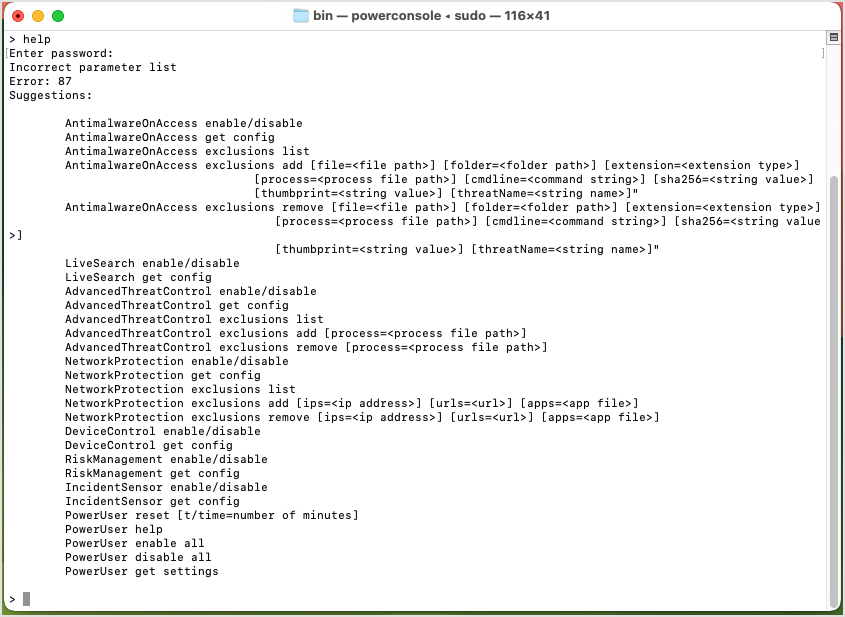Using the Power User module
Overview
Enabling the Power User module in BEST for Mac allows you to use it for troubleshooting purposes.
On macOS, Power User operates via commands executed through a command-line interface application called PowerConsole.
A password is required to execute specific Power User commands. However, no password is needed to run general commands such as querying feature statuses.
Note
The Power User module is available starting with BEST for Mac version 7.21.53.200096.
Install Power User
The default installation kit does not include the Power User module. You need to configure the installation package and add the module to it.
New installation
To install BEST along with the Power User module, follow these steps:
Configure the installation package:
Log in to GravityZone Control Center.
Go to the Network page from the left-side menu and click on the Installation packages section.
Click the Add button. A configuration window is going to be displayed.
Complete the fields with the necessary information.
Select Power User along with all other modules that you want to install.
Save your changes.
Install BEST locally or remotely.
After you have created the package, you can download and run it on your endpoint, or you can install BEST remotely. For more information, refer to Install security agents - standard procedure.
Existing installation
To add the Power User module when BEST is already installed on the endpoint, follow these steps:
Log in to the GravityZone Control Center.
Go to the Network page from the left-side menu.
Select the endpoints where you want to install the module.
Click the Actions button at the upper side of the table and choose Reconfigure agent.
Select Power User and any other modules you want to install.
Note
For more information on using the Reconfigure agent task, refer to Reconfigure agent.
Click Save.
Enable Power User
After the module is installed on the machine, follow these steps:
Log in to GravityZone Control Center.
Go to the Policies page from the left-side menu.
Select the applied policy or the one that you want to apply on your endpoints.
Go to General > Agent and click Settings.
Click the Power User toggle to enable the feature.
Set a password.
Click the Save button.
Apply the policy, if it was not applied previously.
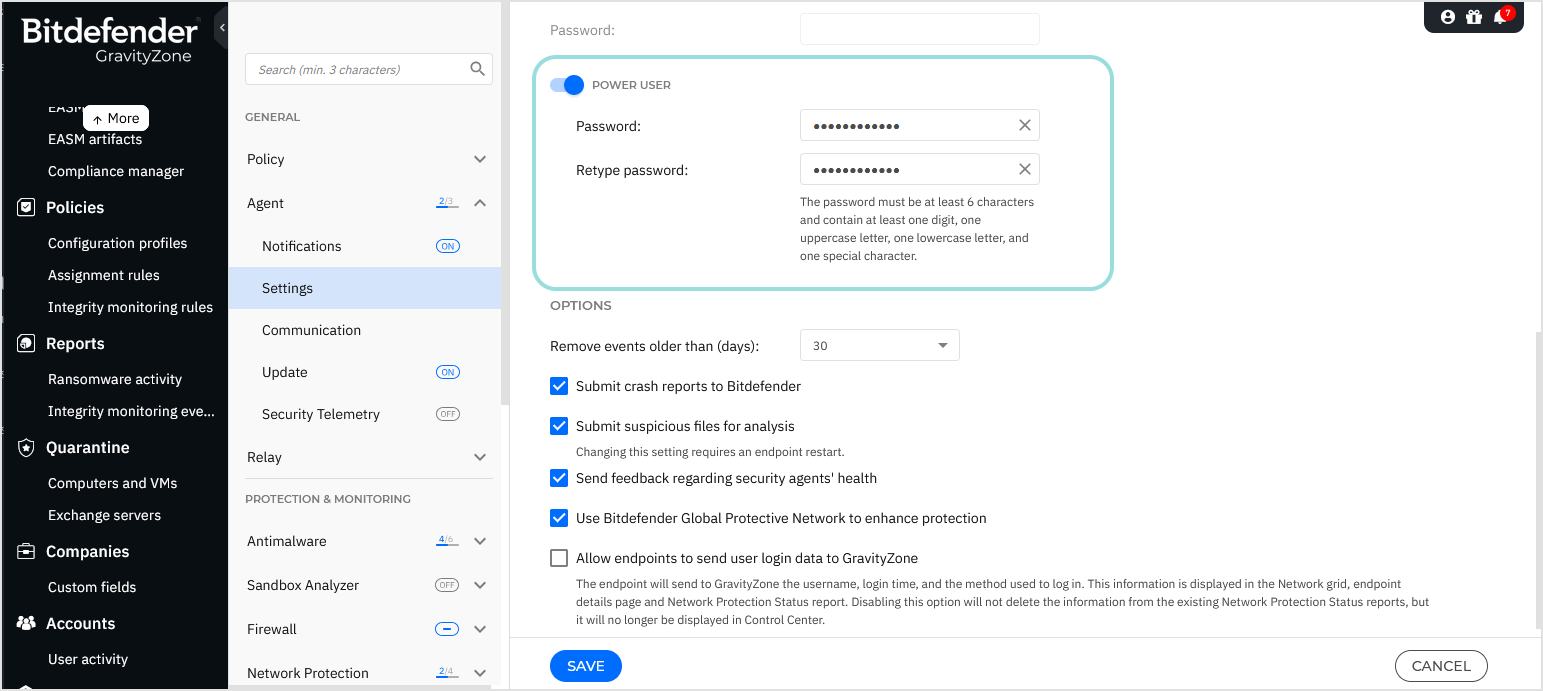
Access Power User
The Power User functionality is managed using the PowerConsole application on your Mac. PowerConsole is located at the following path:
/Library/Bitdefender/AVP/product/bin/PowerConsole
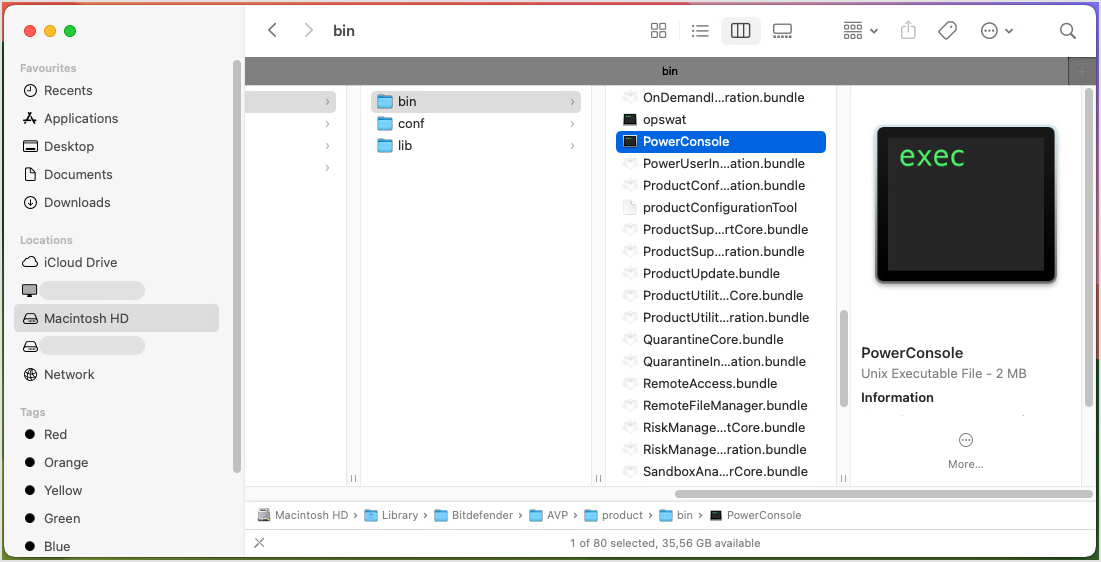
To access Power User, follow these steps:
Open Terminal on your Mac.
Navigate to the folder where PowerConsole is located.
cd /Library/Bitdefender
/AVP/product/bin/Open PowerConsole as root.
When asked, enter the root password.
Execute supported commands.
For certain commands, you must enter the Power User password.
For details on executing commands in PowerConsole, refer to Use the Power User module.
For the list of supported commands and examples, refer to Power User commands.
Manage Power User
To easily find endpoints with policies modified in Power User mode, follow these steps:
Apply filters
Log in to the GravityZone Control Center.
Go to the Network page from the left-side menu.
Go to Filters area and click the More field.
Select Policy type and click Apply.
In the new Policy type filter, select the Edited by Power User option and click Apply.
Check the endpoint
Log in to the GravityZone Control Center.
Go to the Network page from the left-side menu.
Click the name of the endpoint you are interested in.
On the information page, click the Policy tab to view the applied policy.
On the information page, click the Protection tab to view the active modules and other related details.
If you have modified the policy in Power User mode, a notification is displayed in the command-line console (Terminal) on your Mac.
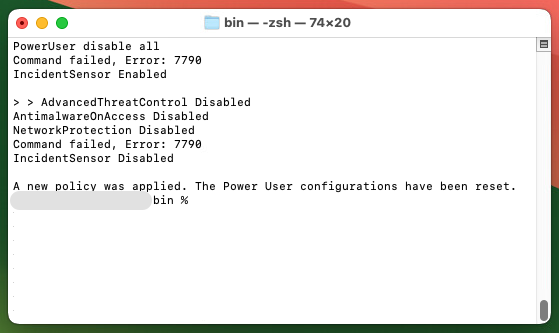
Revert the changes made with Power User
To revert the changes made in Power User mode, use one of the following methods.
Save the applied policy again
Log in to the GravityZone Control Center.
Go to the Policies page from the left-side menu.
Open the policy template assigned to the endpoint with Power User rights.
Click Save.
The original settings are reapplied to the target endpoint.
Assign a new policy
Log in to the GravityZone Control Center.
Go to the Network page from the left-side menu.
Open the Actions menu or right-click the endpoint with Power User rights.
Select the Assign policy option.
Select a different policy.
Click Save.
Use the Power User module
You can execute Power User commands with PowerConsole by following any of these methods:
Via interactive product console session
As individual commands
Interactive session
A PowerConsole interactive session can be started by launching a PowerConsole session without any arguments. During the interactive session, the Power User module can receive and process as many commands as you want.
For Power User commands to have effects, the feature must be enabled and have a password configured. This precondition will be set only once via policy.
During an interactive session, you will be prompted to enter the Power User password only one time. All commands used afterwards will not require a password.
If the password you have entered is incorrect, the command will not be executed. If 5 consecutive incorrect passwords are entered, there will be a timeout of 5 minutes in which no commands can be executed.
Note
If the Power User password is changed during an interactive session, the new password will be requested for the next command.
Power User commands are not case-sensitive.
Example:
Open Terminal.
Navigate to the PowerConsole folder.
cd /Library/Bitdefender/AVP/Product/bin/
Open PowerConsole as root.
sudo ./PowerConsole
Enter your root password to access the interactive mode.
Enter any supported command.
AntimalwareOnAccess enable
Enter the Power User password.
The password is required for the first command. Subsequent commands no longer require the Power User password.
Enter the
qcommand to exit the interactive mode.If you re-enter the interactive mode in the same session, you are no longer asked for the root password.
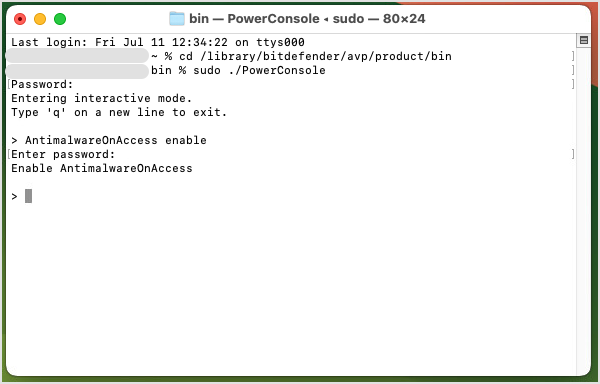
Individual Power User commands
Any Power User command can also be individually sent as an argument to the PowerConsole session, using the Terminal.
Note
Power User commands are not case-sensitive.
The syntax is as follows:
./PowerConsole /c <PowerUser command>
The product console will request the Power User password as input and will perform the requested action if the password is correct.
Regardless of the outcome of the command (successfully processed, wrong command, wrong password etc.), the PowerConsole session will exit on finish.
Example:
Open Terminal.
Navigate to the PowerConsole folder.
cd /Library/Bitdefender/AVP/Product/bin/
Execute the command as root.
sudo ./PowerConsole /c AntimalwareOnAccess enable
Enter your root password.
Enter the Power User password.
For the subsequent commands in the same PowerConsole session, you will be only asked for the Power User password.
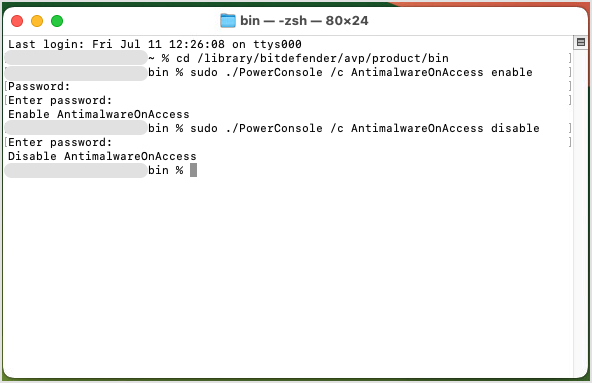
Power User commands
Power User supports commands as listed below.
Note
Power User commands are not case-sensitive.
PowerUser help
This command lists all the available Power User commands based on your installed features.
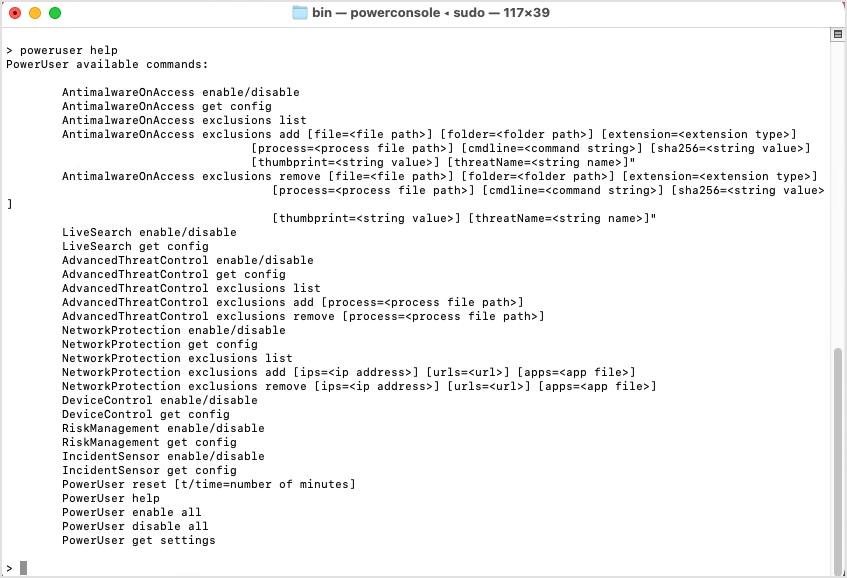
<Feature> enable or <Feature> disable
These commands either enable or disable the selected feature.
The available features are:
AntimalwareOnAccessAdvancedThreatControlNetworkProtectionIncidentSensorDeviceControlRiskManagementLiveSearch
Note
You can enable, disable or query Network Protection, if you have at least one feature installed from the Network Protection suite.
Examples:
AdvancedThreatControl enable
NetworkProtection disable
PowerUser enable all or PowerUser disable all
These commands enable or disable all features that can be modified in Power User.
PowerUser reset, PowerUser reset t, and PowerUser reset time
This command resets all changes performed through the Power User module by re-applying the most recent GravityZone policy.
The t or time optional parameters are used to set the number of minutes until the policy is reapplied.
For example, if you want Power User to reset after 10 minutes, you must use the following command:
PowerUser reset t=10
<Feature> get config
This command showcases the status of the selected feature.
Note
This command will display statuses only for installed features.
Example:
NetworkProtection get config
PowerUser get settings
This command returns an overview of all available features, along with their statuses and exclusions (if available).
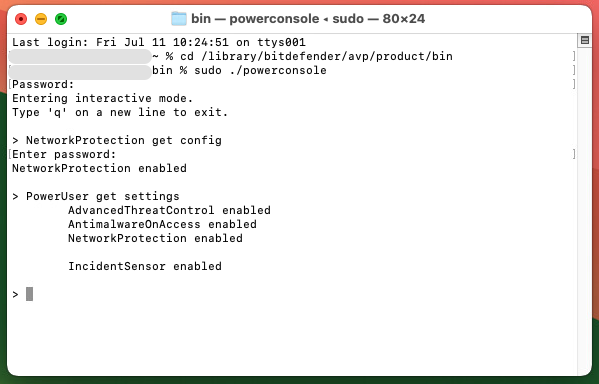
Advanced Threat Control exclusions
The following commands can be used for ATC exclusions:
AdvancedThreatControl exclusions listAdvancedThreatControl exclusions [add process=<process file path>]AdvancedThreatControl exclusions remove [process=<process file path>]
Note
You can only add or remove one exclusion per command. You can also select and copy the exclusions found in Power User and paste them into the add or remove commands.
Examples:
AdvancedThreatControl exclusions list
AdvancedThreatControl exclusions add process=/Applications/Google Chrome.app/Contents/MacOS/Google Chrome
AdvancedThreatControl exclusions remove process=/Applications/Google Chrome.app/Contents/MacOS/Google Chrome
Antimalware On-access exclusions
The following commands can be used for Antimalware On-access scan exclusions:
AntimalwareOnAccess exclusions listAntimalwareOnAccess exclusions add [file=<file path>] [folder=<folder path>] [extension=<extension type>] [process=<process file path>] [cmdline=<command string>] [sha256=<string value>] [thumbprint=<string value>] [threatName=<string name>]AntimalwareOnAccess exclusions remove [file=<file path>] [folder=<folder path>] [extension=<extension type>] [process=<process file path>] [cmdline=<command string>] [sha256=<string value>] [thumbprint=<string value>] [threatName=<string name>]
Note
You can only add or remove one exclusion per command. You can also select and copy the exclusions found in Power User and paste them into the add or remove commands.
Examples:
AntimalwareOnAccess exclusions list
AntimalwareOnAccess exclusions add file=/Users/admin/Desktop/invoice_2025.pdf
AntimalwareOnAccess exclusions remove file=/Users/admin/Desktop/invoice_2025.pdf
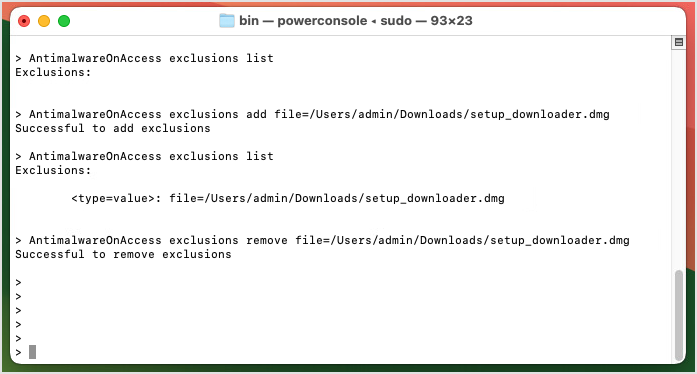
Network Protection exclusions
The following commands can be used for Network Protection exclusions:
NetworkProtection exclusions listNetworkProtection exclusions add [ips=<ip address>] [urls=<url>] [apps=<app file>]NetworkProtection exclusions remove [ips=<ip address>] [urls=<url>] [apps=<app file>]
Note
You can only set one value per exclusion and one exclusion per command. You can also select and copy the exclusions found in Power User and paste them into the add or remove commands.
Examples:
NetworkProtection exclusions list
NetworkProtection exclusions add ips=192.168.1.15
NetworkProtection exclusions remove ips=192.168.1.15
Power User suggestions
The module offers suggestions when a command is incorrect or incomplete.
Note
Your insights and suggestions play an important role in helping us enhance and refine the new Power User CLI module. Let us know what you think.
